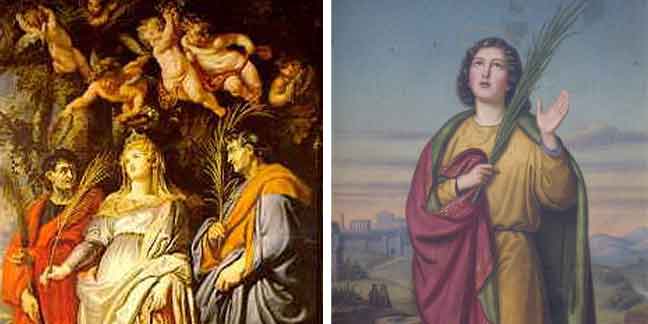On May 5, Catholics celebrate St. Hilary of Arles, a fifth-century bishop who gave up wealth and privilege in favor of austerity and sacrifice for the sake of the Church.
Hilary was born during the year 401, most likely in the present-day French region of Loraine. He came from a wealthy background and received a traditional aristocratic education in philosophy and rhetoric, which he expected to put to use in a secular career.
One of Hilary's relatives, Honoratus, had founded a monastery in Lerins and given his life to the service of the Church. Honoratus was deeply concerned for Hilary's salvation, and urged him with tears to abandon worldly pursuits for the sake of following Christ.
"On one side," Hilary later recalled, "I saw the Lord calling me; on the other the world offering me its seducing charms and pleasures. How often did I embrace and reject, will and not will the same thing!"
"But in the end Jesus Christ triumphed in me. And three days after Honoratus had left me, the mercy of God, solicited by his prayers, subdued my rebellious soul."
Hilary returned to his relative, humbling himself as Honoratus' disciple and embracing his life of prayer, asceticism and Scripture study. He sold his property, gave the proceeds to the poor, and wholeheartedly embraced the monastic life of the community in Lerins.
In 426, Honoratus became the Archbishop of Arles. Hilary initially followed him, but soon returned to the monastery at Lerins. Honoratus, however, insisted on having the assistance of his relative and disciple, and traveled to Lerins himself to retrieve him.
When Honoratus died in 429, Hilary again attempted to leave Arles and return to his monastery. But the faithful of the city sent out a search party and had him brought back, so that he could be consecrated as Honoratus' successor.
Though he was not yet 30 years old, the new archbishop was well-prepared by his years in religious life and the time spent assisting his predecessor. As archbishop, he maintained the simplicity of a monk. He owned few possessions, put the poor ahead of himself, and continued to do manual labor.
Known for his kindness and charity, the archbishop was also remembered for publicly rebuking a government official who brought shame on the Church. He also warned lukewarm believers that they would "not so easily get out of hell, if you are once unhappily fallen into its dungeons."
Hilary helped to establish monasteries in his diocese, and strengthened the discipline and orthodoxy of the local Church through a series of councils. He sold Church property in order to pay the ransoms of those who had been kidnapped, and is said to have worked miracles during his lifetime.
St. Hilary of Arles died on May 5, 449. Although his short life was marked by some canonical disputes with Pope St. Leo I, the pope himself praised the late Archbishop of Arles in a letter to his successor, honoring him as "Hilary of holy memory."
-- Benjamin Mann, Catholic News Agency
 So often we hear people or even ourselves excuse an action by saying “I was only following orders.” But for Nereus and Achilleus this excuse could not stand in the face of the cross.
So often we hear people or even ourselves excuse an action by saying “I was only following orders.” But for Nereus and Achilleus this excuse could not stand in the face of the cross.
Nereus and Achilleus were Roman soldiers of the Praetorian Guard (the emperor’s bodyguards) who were martyred at the end of the first century, and were said to have been baptized by St. Peter himself.
When they became Christians they gave up their posts, which they saw as immoral, and were exiled and then killed under the reign of the emperor Trajan.
Everything we know from authority about the two first-century martyrs comes from a testimony written by Pope St. Damasus in the fourth century and inscribed on a memorial tablet that commemorates their lives. But even this commentary comes 300 years after they died.
The epitaph written by St. Damasus says the following: “Nereus and Achilleus the martyrs joined the army and carried out the cruel orders of the tyrant, obeying his will continually out of fear. Then came a miracle of faith. They suddenly gave up their savagery, they were converted, they fled the camp of their evil leader, throwing away their shields, armor, and bloody spears. Professing the faith of Christ, they are happy to witness to its triumph. From these words of Damasus understand what great deeds can be brought about by Christ’s glory.”
As participants in the persecution they knew perhaps better than any other Christian what pain awaited them. Faith, however, had triumphed over fear of death and the victory of faith was the sweetest they had known. We are told they were martyred, but Damasus doesn’t mention how.
Later legend had it that they served Flavia Domitilla, the great-niece of Emperor Domitian, and were exiled and executed with her when she converted. This legend probably originated in the fact that the martyrs were buried in what was later known as the cemetery of Domitilla.
St. Pancras, or Pancratius, was a Syrian boy of pagan origin who went to Rome and was converted to Christianity. He was beheaded in 304 at the age of 14 during the persecution of the Emperor Diocletian. He is buried on the Via Aurelia in Rome and the Church of St. Pancratius, which still stands today, was built on his grave in the fourth century.
Sts. Nereus, Achilleus and Pancras have been honored together on May 12 since the fourth century.
— Catholic News Agency and Catholic Online

